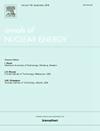Experimental study of multi-mechanism flow instabilities in low-pressure natural circulation systems for pool type heating reactor
IF 1.9
3区 工程技术
Q1 NUCLEAR SCIENCE & TECHNOLOGY
引用次数: 0
Abstract
In the two-phase thermal system, flow drift or self-sustaining oscillation is easy to occur, resulting in mechanical vibration or thermal stress damage, disturbing system control and even inducing boiling crisis in advance. The deep pool heating reactor is a complex low-pressure natural circulation system under the condition of loss of flow accident. Therefore, it is necessary to study the flow instability under such condition. In this paper, a series of transient performance data including inlet flow rate are obtained by building a simulation test bench. It is found that the oscillation characteristics of inlet flow change obviously with the small heating power increase (5 kW) when it is more than 120 kW. By distinguishing the causes of different flow oscillations, we found that there are many different flow instability mechanisms in this system, including pressure drop oscillations, geysering, flashing induced instability and density-wave oscillations. Among them, the longest pressure drop oscillations cycle reaches 449 s, and the relative amplitude reaches 33.9 %. The coupled density-wave oscillations phenomenon triggered by the lowest point of pressure drop oscillations causes the flow stagnation. Through the windowed fast Fourier transform and empirical mode decomposition method, we quantitatively and qualitatively analyze the effects of the interaction between different types of flow instability. we found that it is precisely because of such effects of the various parts above-mentioned that the strong nonlinear characteristics are caused. The experimental data show that the maximum heating power of the reactor during the accident should not exceed 120 kW (corresponding to 60.74 % of the design operating power). This study believes that adjusting the internal characteristic curve of the system will significantly improve the stability of such system.
池式加热堆低压自然循环系统多机制流动不稳定性实验研究
在两相热系统中,容易发生流动漂移或自持续振荡,造成机械振动或热应力损伤,干扰系统控制,甚至诱发沸腾危机。深池加热堆是在失流事故条件下的复杂低压自然循环系统。因此,有必要对这种条件下的流动不稳定性进行研究。本文通过建立仿真试验台,获得了包括进口流量在内的一系列瞬态性能数据。研究发现,当加热功率大于120kw时,当加热功率增加较小(5 kW)时,进口气流振荡特性发生明显变化。通过对不同流动振荡成因的区分,发现该体系存在多种不同的流动不稳定机制,包括压降振荡、间歇泉振荡、闪变不稳定和密度波振荡。其中,压降振荡周期最长可达449 s,相对幅值达到33.9%。由压降振荡最低点引发的密度波耦合振荡现象导致了流动停滞。通过加窗快速傅里叶变换和经验模态分解方法,定量和定性地分析了不同类型流动不稳定性之间相互作用的影响。我们发现,正是由于上述各部分的作用,才造成了较强的非线性特性。实验数据表明,事故发生时反应堆的最大发热功率不应超过120kw(相当于设计运行功率的60.74%)。本研究认为,调整系统内部特性曲线将显著提高系统的稳定性。
本文章由计算机程序翻译,如有差异,请以英文原文为准。
求助全文
约1分钟内获得全文
求助全文
来源期刊

Annals of Nuclear Energy
工程技术-核科学技术
CiteScore
4.30
自引率
21.10%
发文量
632
审稿时长
7.3 months
期刊介绍:
Annals of Nuclear Energy provides an international medium for the communication of original research, ideas and developments in all areas of the field of nuclear energy science and technology. Its scope embraces nuclear fuel reserves, fuel cycles and cost, materials, processing, system and component technology (fission only), design and optimization, direct conversion of nuclear energy sources, environmental control, reactor physics, heat transfer and fluid dynamics, structural analysis, fuel management, future developments, nuclear fuel and safety, nuclear aerosol, neutron physics, computer technology (both software and hardware), risk assessment, radioactive waste disposal and reactor thermal hydraulics. Papers submitted to Annals need to demonstrate a clear link to nuclear power generation/nuclear engineering. Papers which deal with pure nuclear physics, pure health physics, imaging, or attenuation and shielding properties of concretes and various geological materials are not within the scope of the journal. Also, papers that deal with policy or economics are not within the scope of the journal.
 求助内容:
求助内容: 应助结果提醒方式:
应助结果提醒方式:


